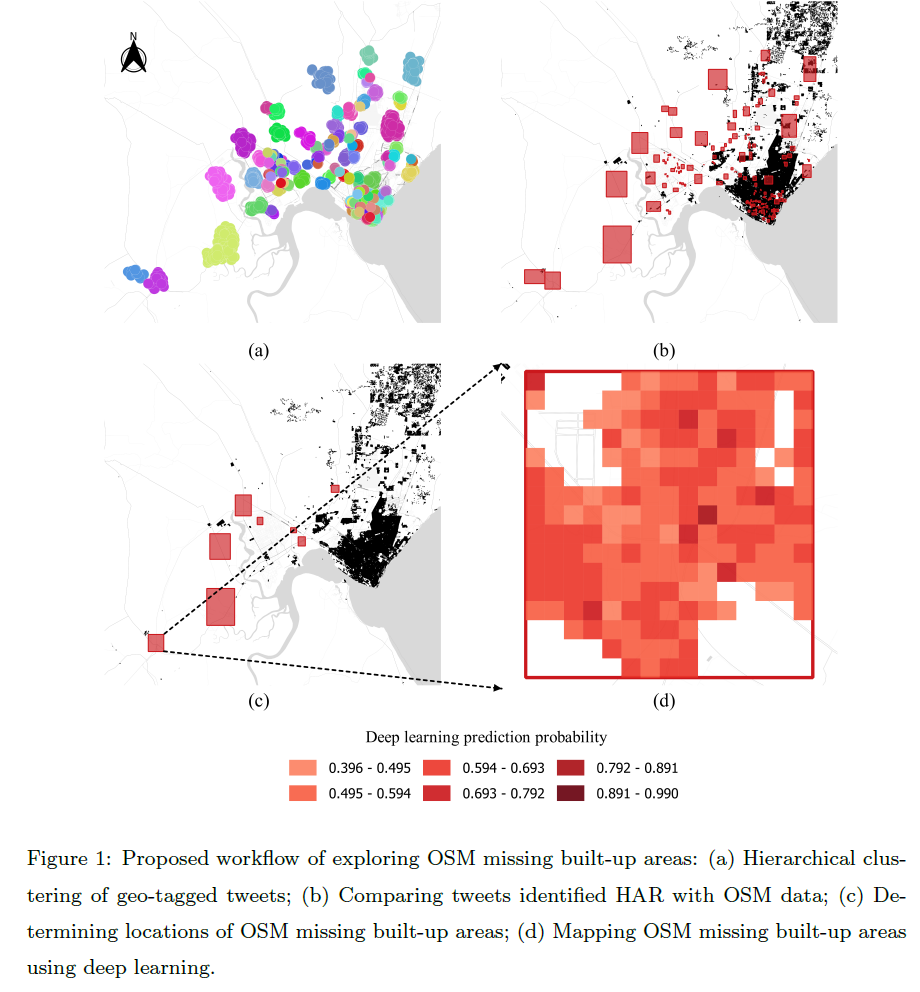We are pleased that our article has been selected by the editors of ISPRS Journal of Photogrammetry and Remote Sensing as the featured Article in August 2020.
This means it will be available open access for 1 year. Get your copy here and enjoy a nice summer reading:
Li, H., B. Herfort, W. Huang, M. Zia, A. Zipf (2020): Exploration of OpenStreetMap missing built-up areas using twitter hierarchical clustering and deep learning in Mozambique Vol. 166, Pages 41-51 https://doi.org/10.1016/j.isprsjprs.2020.05.007
Accurate and detailed geographical information digitizing human activity patterns plays an essential role in response to natural disasters. Volunteered geographical information, in particular OpenStreetMap (OSM), shows great potential in providing the knowledge of human settlements to support humanitarian aid, while often the availability and quality of OSM remains a major concern. The majority of existing research in assessing OSM data quality focus on either extrinsic or intrinsic analysis, which is insufficient to fulfill the humanitarian mapping scenario to a certain degree. A recently accepted paper aims to explore missing built-up areas in OSM from a perspective integrating social sensing and remote sensing.
A new workflow has been developed to estimate and map those missing residential areas in OSM:
- First, applying hierarchical DBSCAN clustering algorithm, the clusters of geo-tagged tweets are generated as proxies of human active regions.
- Then a deep learning based model fine-tuned on existing OSM data is proposed to further map the missing built-up areas.
Hit by Cyclone Idai and Kenneth in 2019, the Republic of Mozambique is selected as the study area to evaluate the proposed method at a national scale. As a result, 13 OSM missing built-up areas have beend identified in that region. They have been mapped with an over 90% overall accuracy. This is competitive compared to state-of-the-art products, which confirms the effectiveness of the proposed method.
Previous related work, e.g.:
- Herfort, B., Li, H., Fendrich, S., Lautenbach, S., Zipf, A. (2019): Mapping Human Settlements with Higher Accuracy and Less Volunteer Efforts by Combining Crowdsourcing and Deep Learning. Remote Sensing 11(15), 1799. https://doi.org/10.3390/rs11151799
- Li, H., Herfort, B., Zipf, A. (2019): Estimating OpenStreetMap Missing Built-up Areas using Pre-trained Deep Neural Networks. 22nd AGILE Conference on Geographic Information Science, Limassol, Cyprus.
- Chen, J., Y. Zhou, A. Zipf and H. Fan (2018): Deep Learning from Multiple Crowds: A Case Study of Humanitarian Mapping. IEEE Transactions on Geoscience and Remote Sensing (TGRS). 1-10. https://doi.org/10.1109/TGRS.2018.2868748
General Overview:
- Yan, Y., C. Feng, W. Huang, H. Fan, Y. Wang & A. Zipf (2020): Volunteered geographic information research in the first decade: a narrative review of selected journal articles in GIScience. International Journal of Geographical Information Science, DOI: 10.1080/13658816.2020.1730848
- Degrossi L.C., J. Porto de Albuquerque, R. dos Santos Rocha, A. Zipf (2018): A taxonomy of quality assessment methods for volunteered and crowdsourced geographic information. Transactions in GIS (TGIS). Wiley. DOI:10.1111/tgis.12329.
- Jokar Arsanjani, J., Zipf, A., Mooney, P., Helbich, M. (Eds.)(2015): OpenStreetMap in GIScience: Experiences, Research, and Applications. Series: Lecture Notes in Geoinformation and Cartography. 2015, VII, 373 p. Sringer Science. Heidelberg, Berlin. ISBN 978-3-319-14279-1
- Scholz, S., Knight, P., Eckle, M., Marx, S., Zipf, A. (2018): Volunteered Geographic Information for Disaster Risk Reduction: The Missing Maps Approach and Its Potential within the Red Cross and Red Crescent Movement. Remote Sensing, 10(8), 1239, doi: 10.3390/rs10081239.



